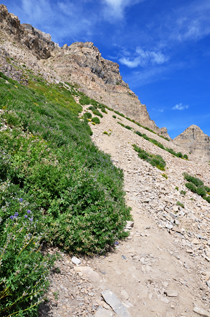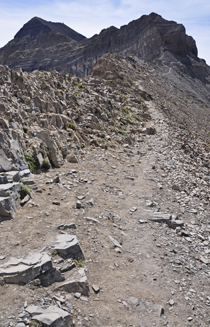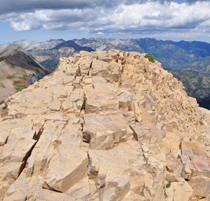Altra Lone Peaks, women’s and men’s, at the peak of Sunset Peak
September 9, 2013. I should be sore. But I’m not. Even after two weeks of steep mountain hiking. Tens of miles on the trail. Miles of elevation gain at high altitudes. My legs never got sore or even tired. Even my feet didn’t get sore. I’m pretty sure it’s my new trail shoes.
I hesitate to tell you or anybody else what to wear. On your feet or any other body part. It’s a little too personal. But I’ve just had such good experiences with these Altra Lone Peak mountain shoes I thought I should tell you. Because I know you’re more likely to hit the trail when you’re confident about having a comfortable, easy hike.
They’re light. They’re completely comfortable. And they make me very, very sure-footed. Balanced and steady on any terrain. If you’ve been avoiding adventurous trails for fear of falling or tiring, you should try these. Here’s why.
The History
For about 10,000 years, we humans ran and hiked without Nikes and other shoes engineered to cushion and correct foot movement. Evolutionary biologists tell us that, before the invention of spears, the ability to outrun game animals – and enemies – for long distances allowed us to catch our dinner and to survive.
Surviving runners are happy runners. And they live to pass on their genes. And so, we’re told, we humans have evolved as barefoot runners and walkers. Runners and walkers who land on the forefoot or midfoot. Not the heel.
Fast forward to the invention of hiking shoes with the heavily padded and elevated heels. Rigid bottoms and stiff, narrow toe boxes. Shoes that cause you to land on your heels. Shoes that cramp and isolate your toes. Which brings us to the big question: Does all this shoe construction help or hurt?
Well, if it gives you blisters, bruises and soreness – that hurts. If the high heel tends to pitch your weight forward, causing you to compensate by leaning back and, maybe, letting your feet slide out from under you … well, that can really hurt.
When I switched to these low-heeled, wide-toed, forward-leaning mountain shoes, all the hurt went away. No toe bruises. No sore hips or knees. And my feet helped themselves. And me.
The Shoes
On a seventeen-mile hike with just under 5,000′ of elevation gain, my legs and feet were working hard on the trail. But zero soreness or tightness during or after the hike. And zero the next day.
How do these shoes make me and my feet so happy to hike? They’re shaped like feet and they have flat heels. Non-elevated heels that keep me comfortably and naturally on my toes. And prevent me from leaning back and slipping. I don’t fall a lot, but when I do, I fall down, not up. It’s only happened hiking downhill, when an elevated boot heel lands hard and pitches me forward. To compensate, I lean backward. Lean too far back and your feet fly out from under you and you’re sitting on the trail. Or rock.
These shoes also have a very wide “toe box”. That’s the front of the shoe. It’s actually foot-shaped: designed to let your toes spread out, naturally and comfortably. So they actually work like toes. Ten little stabilizers that are amazingly good at keeping you balanced. Especially on the way back down the mountain.
I’m not going to enter any mountain goat competitions, but I really appreciated the lightness and flexibility of the shoes and the agility they allow when you’re on a rocky New England trail like the Appalachian Trail. In traditional hiking shoes and boots, I always felt like my feet were in boxes with flat, rigid bottoms and sides. Box-shaped, not foot-shaped. So I always felt flat-footed, teetering on the top of each and every rock and boulder I stepped on. With the Lone Peaks, I feel like I’m hopping from stone to stone. With the greatest of ease.
They’re very light, as close as you can get to barefoot hiking without destroying your soles. One of the layers in the shoe’s cushioned bottom is called “Stoneguard”. I don’t know what it’s made from, but when you step on a sharp rock edge with your mid-foot, there’s no “ouch”.
These shoes took me here …
… then here …
… and, finally, to the peak of Mt. Timpanogos. 4,900′ above and 8 miles from the trailhead.
Everybody loves them
I thought it was just me. And Kathy. But, no … Runner’s World magazine just named the Lone Peak “Editor’s Choice” in the Trail Shoe category.
Every Thing Is Everything
This study shows that “use of flat, flexible footwear results in significant reductions in knee loading in subjects with OA [osteoarthritis]. By 24 weeks, there is evidence of a gait adaptation with sustained load reduction even when the mobility shoes are removed, suggesting that footwear may serve as a biomechanical training device to achieve beneficial alterations in gait mechanics for knee OA.” Reduction in “knee loading” reduced pain and slowed the progression of the disease. Might want to wear these shoes even when you’re not hiking. The study was reported in the journal, “Arthritis and Rheumatism”.



